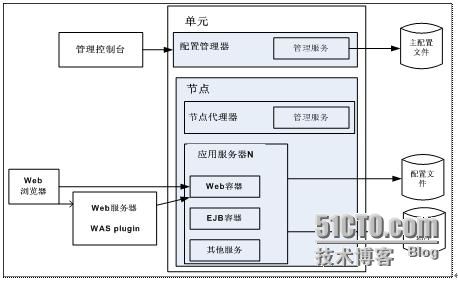WAS应用服务器搭建与管理
一些j2ee知识
WAS是典型的j2ee服务器,在开始WAS之前,了解一些j2ee的知识.
J2EE全称为Java2 Platform Enterprise Edition
J2EE平台本质上是一个分布式的服务器应用程序设计环境——一个Java环境,它提供了:
宿主应用的一个运行基础框架环境。一套用来创建应用的Java扩展API。
大体上J2EE可以分成3个主要应用:Servlet/JSP,EJB,XML/Web Service 和一些支撑技术例如JDBC和JNDI.
Servlet是运行在Web服务器上的程序,主要是处理Http(s)请求并作出响应,包括返回一个HTML页面或转交给其他URL处理。在来自Web浏览器或其他HTTP客户机的请求与HTTP服务器上的数据库或应用程序之间起一个中间层的作用。
JSP(JavaServer Pages)是一种基于Java的脚本技术。在JSP 的众多优点之中,其中之一是它能将 HTML 编码从 Web 页面的业务逻辑中有效地分离出来。用 JSP 访问可重用的组件,如 Servlet、JavaBean 和基于 Java 的 Web 应用程序。JSP 还支持在 Web 页面中直接嵌入 Java 代码。最终会编译成class。
EJB,全称Enterprise Java Bean。EJB 从技术上而言不是一种"产品" ,而是一个技术规范。
一个ejb是由java开发的,可以部署的,服务器端的组件.其包括
若干.java程序,
一个xml格式的部署文件,
一个j2ee容器的专门部署文件。
EJB程序经过部署,在weblogic等容器上运行,自动实现中间件的特性
3.WAS相关概念
概要文件profile、应用服务器server、节点node、单元cell
Profile是WAS 6.0版本之后才有的。其目的是将WAS本身的文件与用户的数据文件从物理上分离,加强管理,减少出错的可能性。安装好WAS之后不能直接来部署应用,首先要根据情况新建不同类型的Profile 。
Profile类型:default、dmgr、managed
default为默认的profile类型,单server模式中使用。
Dmgr、managed 类型在集群模式中使用,不同的是dmgr是Deployment Manager 为分布式单元的所有元素的管理中心,而managed受dmgr管控,其本质上是节点node。
Server是最小的处理单元
Node是一个或者多个Server的分组,Node只能在一台物理机器上存在,不能跨机器
Node基本上等同于Profile,Node是管理概念,而Profile是实际的概要文件
Cell是一个或者多个Node的分组,是最大作用域。
Cell保留它所管辖的所有Node的配置,Node的配置以Cell的配置为准。
NodeAgent:在集群环境下,DM(Deployment Manager Server )可以透过NodeAgent对Node中的Server进行管理
如果不是集群环境,则一个Node下面只能有一个Server,可以创建多个profile来做到单机多server。
如图

4、was应用服务器搭建
4.1 创建集群环境profile
新建一个WAS(AIX)
以建立TDCS的控制台为例
在/usr/WebSphere/AppServer/bin下,有wasprofile.sh 脚本。
如果是window,则为wasprofile.bat。
4.1.1编辑好端口文件
如ports.dmgr 内容如下:
WC_defaulthost=39083
WC_adminhost=39063
WC_defaulthost_secure=39446
WC_adminhost_secure=39046
BOOTSTRAP_ADDRESS=39812
SOAP_CONNECTOR_ADDRESS=38882
SAS_SSL_SERVERAUTH_LISTENER_ADDRESS=39407
CSIV2_SSL_SERVERAUTH_LISTENER_ADDRESS=39417
CSIV2_SSL_MUTUALAUTH_LISTENER_ADDRESS=39427
ORB_LISTENER_ADDRESS=39122
CELL_DISCOVERY_ADDRESS=37280
DCS_UNICAST_ADDRESS=39355
其中,adminhostSOAP端口后续的dmgr、managed中会使用到。
4.1.2创建dmgr
语法:
wasprofile.sh -create
-profileName profile_name
-profilePath fully_qualified_profile_path
-templatePath template_path
-nodeName node_name
-cellName cell_name
-hostName host_name
-server iSeries_server_name
[-startingPort starting_port | -portsFile filepath]
-winserviceCheck true | false
-winserviceAccountType specifieduser | localsystem
-winserviceUserName yourusername
-winservicePassword yourpassword
-winserviceStartupType manual | automatic | disabled
[-debug]
如:
./wasprofile.sh
-create
-profileNameDmgr_TDCS
-profilePath/usr/WebSphere/AppServer/profiles/Dmgr_TDCS
-templatePath/usr/WebSphere/AppServer/profileTemplates/dmgr
-nodeName Dmgr_TDCS
-cellName Cell_TDCS
-hostName S1_C_CS_GC
-portsFile/usr/WebSphere/AppServer/bin/TDCS.ports
其中nodeName, cellName 要不一致
创建成功后,会提示
./wasprofile.sh
-create
-profileName Dmgr_TDCS
-profilePath/usr/WebSphere/AppServer/profiles/Dmgr_TDCS
-templatePath/usr/WebSphere/AppServer/profileTemplates/dmgr
-nodeName Dmgr_TDCS
-cellName Cell_TDCS
-hostName S1_C_CS_GC
-portsFile/usr/WebSphere/AppServer/bin/TDCS.ports
INSTCONFSUCCESS:Success: The profile now exists.
4.1.2创建manged
语法
wasprofile.sh -create
-profileName profile_name
-profilePath fully_qualified_profile_path
-templatePath template_path
-nodeName node_name
-cellName cell_name
-hostName host_name
-server iSeries_server_name
[-startingPort starting_port | -portsFile filepath]
-winserviceCheck true | false
-winserviceAccountType specifieduser | localsystem
-winserviceUserName yourusername
-winservicePassword yourpassword
-winserviceStartupType manual | automatic | disabled
[-debug]
如:
创建Cluster_2_TDCS
./wasprofile.sh
-create
-profileName Cluster_2_TDCS
-profilePath /usr/WebSphere/AppServer/profiles/Cluster_2_TDCS
-templatePath /usr/WebSphere/AppServer/profileTemplates/managed
-nodeNameNode2_TDCS
-cellNameCell_TDCS2
-hostName S1_C_CS_GC
执行完毕之后,提示successful
./wasprofile.sh
-create
-profileName Cluster_2_TDCS
-profilePath/usr/WebSphere/AppServer/profiles/Cluster_2_TDCS
-templatePath/usr/WebSphere/AppServer/profileTemplates/managed
-nodeName Node2_TDCS
-cellName Cell_TDCS
-hostName S1_C_CS_GC
INSTCONFSUCCESS: Success: The profile nowexists.
注意,nodename,cellname要不一致。
完成之后,在/usr/WebSphere/AppServer/profiles
可以看到Dmgr_TDCS、Cluster_2_TDCS文件夹。
4.1.2启动Dmgr
在/usr/WebSphere/AppServer/profiles/bin目录下,
启动脚本 ./StartManger.sh 脚本,提示成功。
4.1.2将managed加入Dmgr管理
在/usr/WebSphere/AppServer/profiles/ Cluster_1_TDCS/bin
目录下,提示成功
执行addNode.sh dmgr主机 soap端口,
./addNode.sh 10.244.147.19938882
ADMU0116I: Tool information is being logged in file
/usr/WebSphere/AppServer/profiles/Cluster_1_TDCJ/logs/addNode.log
ADMU0128I: Starting tool with the Cluster_1_TDCJ profile
ADMU0001I: Begin federation of node Node1_TDCJ with Deployment Managerat
10.244.147.199:38882.
ADMU0001I: Begin federation of node Node1_TDCJ with DeploymentManager at
10.244.147.199:38882.
ADMU0009I: Successfully connected to Deployment Manager Server:
10.244.147.199:38882
ADMU0507I: No servers found in configuration under:
/usr/WebSphere/AppServer/profiles/Cluster_1_TDCJ/config/cells/Cell_TDCJ1/nodes/Node1_TDCJ/servers
ADMU2010I: Stopping all server processes for node Node1_TDCJ
ADMU0024I: Deleting the old backup directory.
ADMU0015I: Backing up the original cell repository.
ADMU0012I: Creating Node Agent configuration for node: Node1_TDCJ
ADMU0014I: Adding node Node1_TDCJ configuration to cell: Cell_TDCJ
ADMU0016I: Synchronizing configuration between node and cell.
ADMU0018I: Launching Node Agent process for node: Node1_TDCJ
ADMU0020I: Reading configuration for Node Agent process: nodeagent
ADMU0022I: Node Agent launched. Waiting for initialization status.
ADMU0030I: Node Agent initialization completed successfully. Processid is:
2850914
ADMU9990I:
ADMU0300I: Congratulations! Your node Node1_TDCJ has beensuccessfully
incorporated intothe Cell_TDCJ cell.
ADMU9990I:
ADMU0306I: Be aware:
ADMU0302I: Any cell-level documents from the standalone Cell_TDCJ1
configuration havenot been migrated to the new cell.
ADMU0307I: You might want to:
ADMU0303I: Update the configuration on the Cell_TDCJ DeploymentManager with
values from the oldcell-level documents.
ADMU9990I:
ADMU0306I: Be aware:
ADMU0304I: Because -includeapps was not specified, applicationsinstalled on
the standalone nodewere not installed on the new cell.
ADMU0307I: You might want to:
ADMU0305I: Install applications onto the Cell_TDCJ cell usingwsadmin $AdminApp
or theAdministrative Console.
ADMU9990I:
ADMU0003I: Node Node1_TDCJ has been successfully federated.
至此,创建部分完成。
4.1创建单机环境profile
4.2.1创建profile的命令:
wasprofile.sh -create
-profileNameprofile_name
-profilePathfully_qualified_profile_path
-templatePathtemplate_path
-nodeName node_name
-cellName cell_name
-hostName host_name
-server iSeries_server_name
[-startingPortstarting_port | -portsFile filepath]
-winserviceCheck true |false
-winserviceAccountTypespecifieduser | localsystem
-winserviceUserNameyourusername
-winservicePasswordyourpassword
-winserviceStartupTypemanual | automatic | disabled
[-debug]
单机环境的-templatePath参数,为default。
如:
./wasprofile.sh
-create-profileName test4sop
-profilePath/websphere/AppServer/profiles/test4sop
-templatePath/websphere/AppServer/profileTemplates/default
-nodeNametest4sopnode
-cellNametest4sopcell
-hostNameS2_E_YZ_JKCS
4.2.2启动server
cd /websphere/AppServer/profiles/test4sop
cd bin
./startServer.sh server1
4.3删除概要文件
当一个概要文件损毁,或者发生迁移时,需要删除原有的概要文件。
要删除一个概要,必须按下列方法操作:
4.3.1 移除一个已经与某个单元联合的自定义概要或应用程序服务器概要
1.停止节点上的应用程序服务器。
2.使用管理控制台或 removeNode 命令,将节点从单元中移除。移除一个节点并不会删除它,只是使它恢复到联合前的配置,该配置以前是作为联合过程的一部分予以保存的。
3.使用 wasprofile -delete 删除概要。
4.使用 wasprofile -validateAndUpdateRegistry 命令清除概要注册中心。
5.删除 <profile_home> 目录。
4.3.2 移除一个未与某个单元联合的应用程序服务器概要
1.停止应用程序服务器。
2.使用 wasprofile -delete 删除概要。
3.使用 wasprofile -validateAndUpdateRegistry 命令清除概要注册中心。
4.删除 <profile_home> 目录。
4.3.3 移除某个部署管理器概要
使用管理控制台或 removeNode 命令,移除与单元联合的所有节点。移除一个节点并不会删除它,只是使它恢复到联合前的配置,该配置以前是作为联合过程的一部分予以保存的。
1.停止部署管理器。
2.使用 wasprofile -delete 删除概要。
3.使用 wasprofile -validateAndUpdateRegistry 命令清除概要注册中心。
4.删除 <profile_home> 目录。
用 wasprofile删除一个概要
要删除一个概要,请使用 wasprofile -delete 命令。其格式是:
wasprofile -delete -profileName <profile>
当该命令完成后,概要将从概要注册中心中移除,除了日志文件之外的运行时组件也将从 <profile_home> 目录中移除。
如果在删除概要时出现了错误,请检查下列日志: <was_home>/logs/manageprofile/<profile_name>_delete.log
注意:如果在删除过程中出现问题,可以手动删除概要。
5、 was资源配置
以营帐中使用到的资源为例。
打开控制台页面,
http://localhost:39063/admin
完成数据源配置,应用发布等工作。
5.1 新建server
检查节点,节点已经存在
相关知识
宠物店管理APP系统搭建
宠物店管理系统源码搭建
宠物行业智能宠物喂养与健康管理平台搭建方案
宠物健康管理APP软件搭建
宠物健康管理系统APP搭建
宠物行业宠物健康管理与医疗服务平台搭建方案.doc
springboot+vue基于Vue的宠物饲养管理系统设计与实现【开题+程序+论文】
RFID应用之宠物管理
基于ssm+vue基于Web的宠物领养管理系统的设计与实现【开题+程序+论文】
宠物行业智能宠物喂养与健康管理平台搭建方案.doc
网址: WAS应用服务器搭建与管理 https://www.mcbbbk.com/newsview992407.html
| 上一篇: Docker环境操作FTP 报错 |
下一篇: Windows7 64位CUDA |
推荐分享

- 1养玉米蛇的危害 28694
- 2狗交配为什么会锁住?从狗狗生 7180
- 3我的狗老公李淑敏33——如何 6236
- 4豆柴犬为什么不建议养?可爱的 4637
- 5南京宠物粮食薄荷饼宠物食品包 4563
- 6中国境内禁养的十大鸟种,你知 4429
- 7湖南隆飞尔动物药业有限公司宠 4259
- 8自制狗狗辅食:棉花面纱犬的美 4257
- 9家养水獭多少钱一只正常 4212
- 10广州哪里卖宠物猫狗的选择性多 4122






